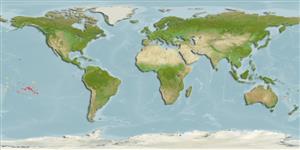Gloripallium spiniferum (Sowerby I, 1835)
| Native range | All suitable habitat | Point map | Year 2050 |

|
| This map was computer-generated and has not yet been reviewed. |
| Gloripallium spiniferum AquaMaps Data sources: GBIF OBIS |
Google image | No image available for this species;
drawing shows typical species in Pectinidae.
Classification / Names Populärnamn | synonymer | CoL | ITIS | WoRMS
Bivalvia | Pectinida | Pectinidae
Environment: milieu / climate zone / djupintervall / distribution range Ekologi
; djupintervall 18 - 32 m (Ref. 97584). Tropical
Distribution Länder | FAO områden | Ekosystem | Förekomster | Utplanteringar
Eastern Central Pacific: French Polynesia and Pitcairn Islands.
Length at first maturity / Size / Weight / Age
Könsmognad: Lm ? range ? - ? cm
Life cycle and mating behavior Könsmognad | Reproduktion | Lek | Eggs | Fecundity | Larvae
Main reference
referenser | Koordinator | Medarbetare
Preece, R.C. 1995 The composition and relationships of the marine molluscan fauna of the Pitcairn Islands. The Pitcairn Island: biogeography, ecology and prehistory. Benton, T. G. and T. Spencer (eds). Biological Journal of the Linnean Society 56:339-358. (Ref. 87907)
IUCN Red List Status
(Ref. 130435: Version 2025-1)
CITES status (Ref. 108899)
CMS (Ref. 116361)
Threat to humans
Human uses
| FishSource |
Verktyg
Ytterligare information
Födosammansättning
Födointag
Predatorer
Max. ages / sizes
Length-weight rel.
Length-length rel.
Length-frequencies
Mass conversion
Abundans
Internet-källor
BHL | BOLD Systems | CISTI | DiscoverLife | FAO(Publication : search) | Fishipedia | GenBank (genome, nucleotide) | GloBI | Gomexsi | Google Books | Google Scholar | Google | PubMed | Tree of Life | Wikipedia (Go, sök) | Zoological Record



